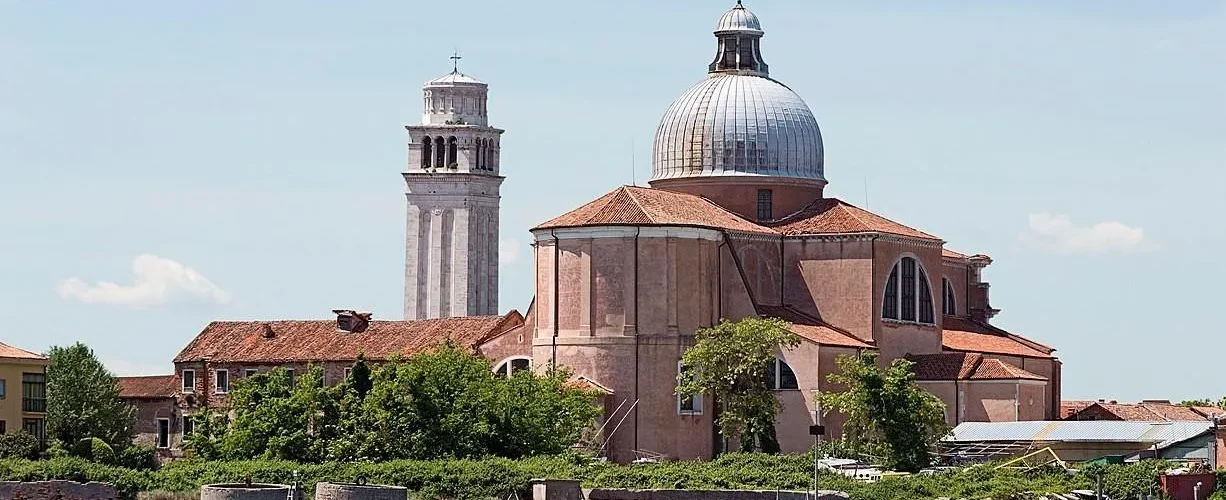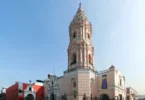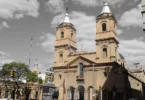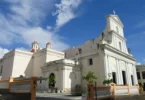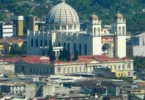Introduction
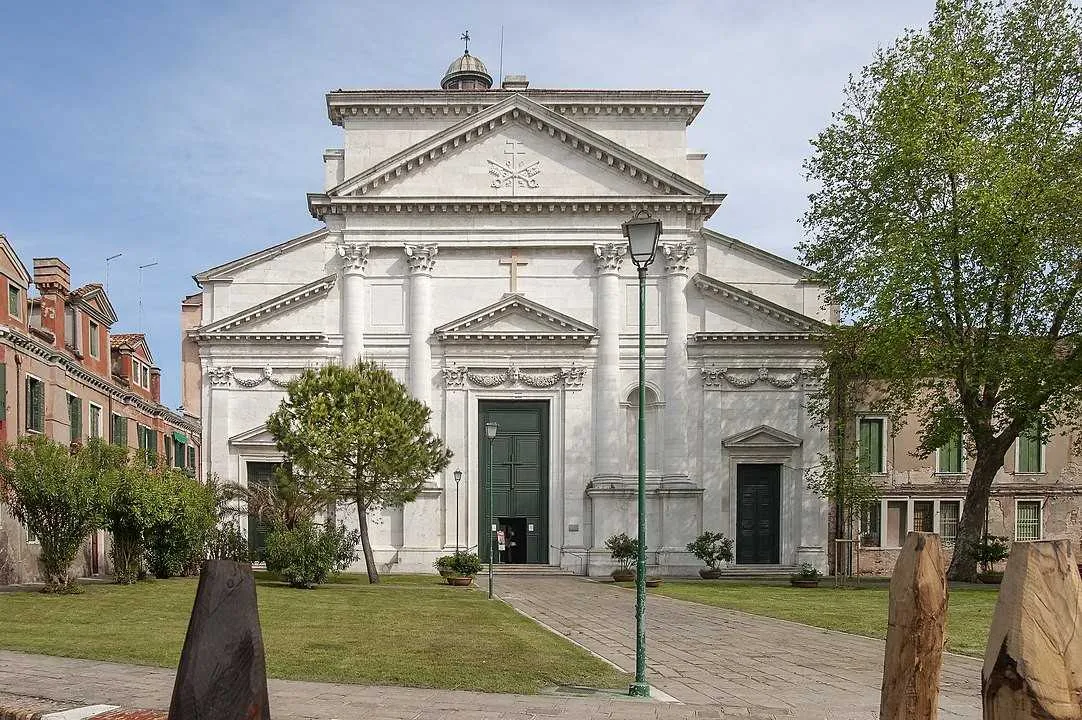
The Basilica di San Pietro di Castello, commonly known as San Pietro di Castello, is a significant Roman Catholic church located in the Castello district of Venice, Italy. Positioned on the small island of San Pietro di Castello, which lies at the northeastern edge of the city, the basilica has been an essential place of worship for centuries. Its proximity to the historic Arsenale docks underscores its deep connection to Venice’s maritime heritage. The current structure of the basilica dates back to the 16th century, although a place of worship has stood on this site since at least the 7th century. This long history speaks to its importance in the spiritual and cultural fabric of Venice. From 1451 to 1807, the basilica served as the cathedral of the Patriarchate of Venice, holding the city’s religious authority during this period. However, despite its official status as a cathedral, it never gained the prominence typical of such churches due to its somewhat remote location and its overshadowing by the far more prominent Basilica di San Marco (St. Mark’s Basilica), which served as the “state church” of Venice.
Over the centuries, the basilica underwent numerous changes and renovations, with many of Venice’s most notable architects contributing to its evolution. One such architect was Andrea Palladio, who was commissioned by Patriarch Vincenzo Diedo to redesign the basilica’s façade and interior. However, following Diedo’s death, Palladio’s work was delayed, leaving the church to evolve through other architectural influences over time. After St. Mark’s Basilica became Venice’s official cathedral, San Pietro di Castello fell into a state of disrepair. Its decline was further compounded during the First World War, when the church was severely damaged by firebombing. Restoration efforts, spearheaded by conservation organizations, have since returned the basilica to its former glory. Today, ongoing conservation and care are overseen by its membership in the Chorus Venezia association, which ensures the preservation of Venice’s most important churches. Today, San Pietro di Castello remains a minor basilica, a title that reflects its continued religious significance, even as it is no longer the main cathedral of Venice. It stands as a vital piece of Venice’s rich religious, historical, and architectural legacy.
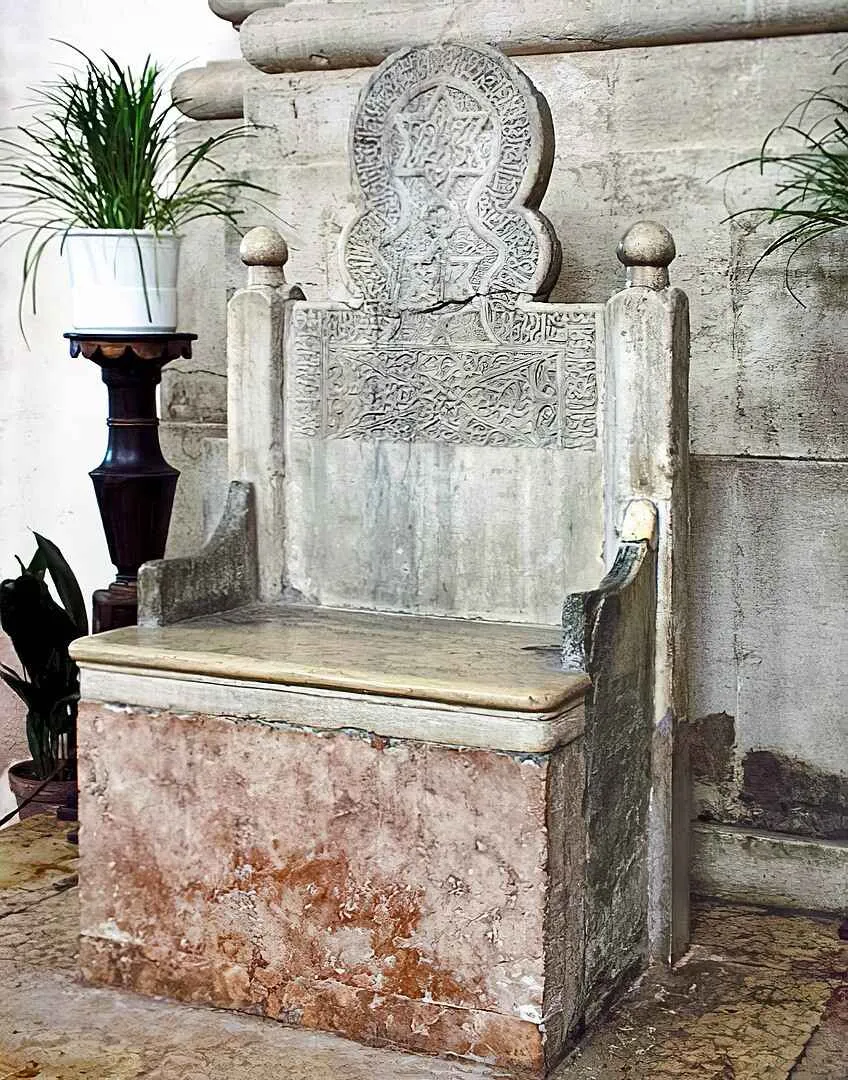
The Basilica di San Pietro di Castello has a rich history dating back to the 7th century, making it one of the oldest churches in Venice. It was originally one of the eight churches founded by St. Magnus (Italian: San Magno), the Bishop of Oderzo, during the early Christian period in the Venetian lagoon. At that time, Venice was not yet a city but rather a collection of small communities spread across the marshy islands. According to tradition, St. Peter (Italian: San Pietro) appeared to St. Magnus in a vision, instructing him to build a church where oxen and sheep were grazing side by side. The site for the church was chosen, and St. Magnus built the first structure, dedicating it to St. Peter.
The first Bishop of Olivolo (the precursor to Venice) was Obelarius (774–798), and it was around this time that the foundations for the church were laid. In 1120, a devastating fire destroyed the original building, necessitating the construction of a new and larger structure. This new design, which was more grandiose than the previous one, was faithfully reproduced on the 16th-century plan by Jacopo de’ Barbari. The new church featured an adjacent baptistery dedicated to St. John the Baptist, which has since been lost. By 1451, the church became the seat of the Patriarch of Venice following the suppression of the Patriarchate of Grado and the establishment of the Diocese of Castello as the Patriarchate of Venice, which is when the church saw significant investments.
During the 1480s, architect Mauro Codussi rebuilt the church’s campanile using white Istrian stone, the first example of this material being used in Venice. Between 1508 and 1524, Patriarch Antonio Contarini oversaw restoration work on the ceiling, vaults, and floor, while smaller chapels were rebuilt and new furnishings and decorations were added. In 1558, Andrea Palladio received his first commission in Venice to design an improved facade and interior for the basilica. However, the Patriarch Vincenzo Diedo, who had commissioned Palladio, passed away in 1559, and Palladio’s plans were never realized. Later, between 1594 and 1596, architect Francesco Smeraldi implemented a more modest and less ambitious version of Palladio’s design, possibly due to limited funds. Between 1619 and 1626, Gerolamo Grapiglia supervised the interior construction under the patronage of Patriarch Giovanni Tiepolo.
From 1630 until the fall of the Republic of Venice, an annual pilgrimage to the basilica took place on January 8, commemorating the city’s liberation from the plague. In 1807, after the fall of the Republic, St. Mark’s Basilica became the official cathedral of Venice, and the patriarchal seat was transferred to San Marco. As a result, the basilica of San Pietro di Castello fell into neglect.
In 1821, under Pope Pius VII, a papal bull called Ecclesias Quae granted San Pietro di Castello the dignity of a minor basilica. Following the transfer of the patriarchal seat to San Marco, the basilica’s parish priest was granted the title of archpriest and was also a canon of San Marco. The adjacent monastery was repurposed into a powder magazine by Eugène de Beauharnais, the viceroy of Italy. During World War I, the basilica’s dome was struck by incendiary bombs, which caused the destruction of the lantern. Despite the damage, conservation efforts in the 1970s helped restore the church to its former glory. Today, the Basilica di San Pietro di Castello stands as an important religious site in Venice and is a member of the Chorus Association of Venetian Churches.
Architecture of Basilica of St Peter of Castello, Venice, Italy
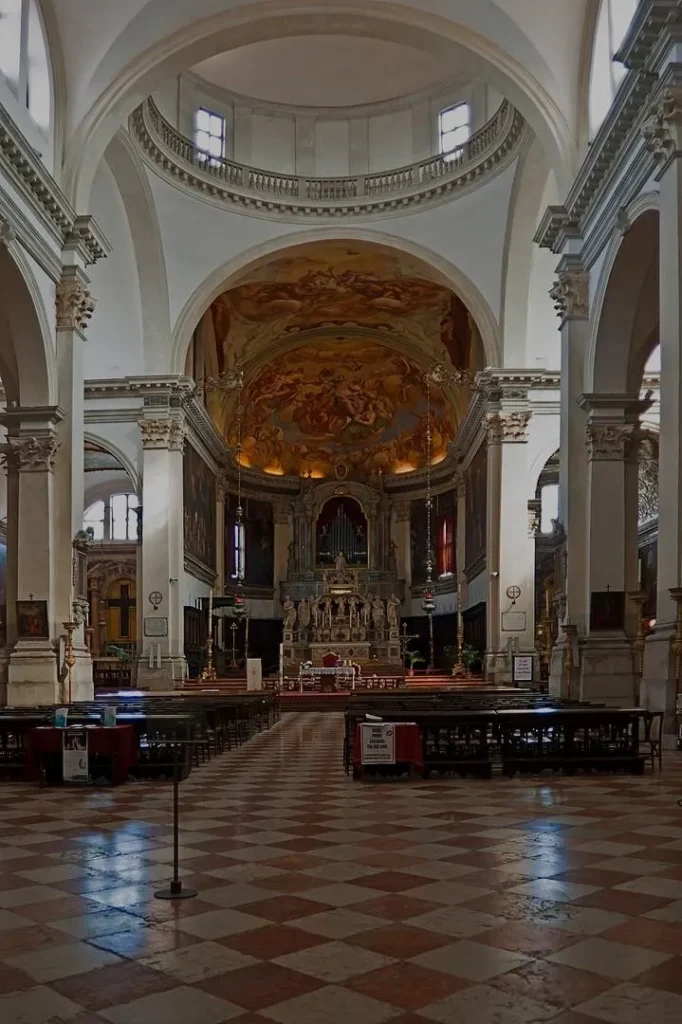
Architectural Styles: Renaissance architecture
Architectural Design and Key Features of the Church
The church’s current design dates back to 1120, following a fire that destroyed the previous structure from 841. The earlier church had three naves, a tripartite façade, and circular apses, with the Baptistery of San Giovanni Battista located nearby, though it is now lost. The present façade, while not an exact replica of Andrea Palladio’s original design from 1568, remains true to its core principles. It features a tripartite arrangement, with a raised central section supported by four semi-columns on bases that culminate in a tympanum. The central nave is emphasized with a major order, while the side naves are highlighted with a minor order. The façade is adorned with a nineteenth-century bas-relief of Charity, sculpted by Marsili, reflecting a classical style.
The interior follows a Latin cross plan, with three naves divided by three arches each, and a central altar. At the intersection of the central nave and transept, a large dome is placed. The deep presbytery extends from the central nave and is flanked by two side chapels. The large main altar, dating from 1646, contains the remains of Saint Lorenzo Giustiniani, the first Patriarch of Venice. The altar was designed by Clemente Molli, who also sculpted several statues for it based on designs by Baldassarre Longhena, the same architect who designed the chapel dedicated to Cardinal Francesco Vendramin, located on the left aisle.
Exterior Architecture
The church’s façade is more understated compared to other Palladian designs in Venice. It features a striking arrangement of four engaged columns with Composite capitals that support the main pediment and entablature. These are flanked by a double broken pediment, adding to the architectural complexity.
A prominent dome crowns the church, emphasizing its ecclesiastical significance, and drawing parallels with Palladio’s designs for San Giorgio Maggiore and Il Redentore. The dome is set on a drum, with rectangular windows carved into it to allow natural light to illuminate the interior. The church’s campanile, however, is considered one of the most precarious in Venice, adding a sense of vulnerability to the church’s impressive exterior.
Interior Architecture
The interior of the church is characterized by a large central nave with Latin aisles. The transept intersects the church, dividing the nave from the presbytery, and the crossing point is crowned by an expansive dome. The Vendramin Chapel, situated off the left aisle, was designed by the Baroque architect Baldassarre Longhena, who also crafted the high altar during the mid-17th century. The organ, constructed by the Dalmatian craftsman Pietro Nachini, was created in the 18th century and remains an important feature of the church’s interior.
Works of Art
The church houses several remarkable works of art, with notable pieces such as the Chair of St. Peter, which, according to tradition, belonged to the Apostle himself during his time as Bishop of Antioch. It is believed to have been gifted to Doge Pietro Tradonico by Eastern Emperor Michael III. In truth, the chair is crafted from the backrest of an ancient Islamic funerary stele, adorned with Arabic decorative motifs and Kufic inscriptions of verses from the Koran: Sura III, vv. 192-194, and Sura XXIII, v. 118, expressing prayers for mercy and forgiveness. In the right aisle, one can find the painting St. Peter in Chair and Four Saints by Marco Basaiti, dating to the 16th century. In the left aisle, the Vendramin Chapel, dedicated to Our Lady of Mount Carmel, features bas-reliefs by Michele Ungaro (1675) and an altarpiece by Luca Giordano (1650) depicting the Madonna and Child with the Souls in Purgatory. Nearby, the Lando Chapel displays a mosaic altarpiece by Arminio Zuccato, possibly based on a design by Jacopo Tintoretto (1570).
Between these two chapels are several works by Veronese, including Saints John the Evangelist, Peter and Paul (1585), The Immaculate Conception by Giovanni Maria Morlaiter (18th century), and The Martyrdom of Saint John the Evangelist by Padovanino. Other significant paintings in the basilica include The Supper at Emmaus by Pietro Malombra and Antonio Vassilacchi, displayed on the left wall of the portal, and The Supper in the House of Simon by Jacopo Beltrame (16th century) on the right. Additionally, two statues by Orazio Marinali—Faith and Meditation—adorn the space, along with the 18th-century Crucifix by Jacopo Strada. The painting Saint George and the Princess and the Dragon by Marco Basaiti, which has been housed in the Gallerie dell’Accademia since 1985, is another key piece in the church’s collection. Finally, in the chapel to the right of the high altar, visitors can admire a large fresco titled The Adoration of the Magi (1658) by Pietro Ricchi, also known as Lucchese. The church also holds a few other masterpieces, including SS John the Evangelist, Peter, and Paul by Paolo Veronese, and a significant 13th-century Throne of St. Peter, carved from a funerary stone.
Pipe Organ
The Nachini Opus 276 pipe organ is located in the choir loft behind the main altar of the church. Built in 1754, the organ was later restored in 1898 by Pietro Bazzani. The instrument features a fully mechanical transmission system and a single keyboard with 57 notes, where the first octave is open. Additionally, the organ includes a pedalboard with 18 notes, with the 18th corresponding to the drum.
The baroque-style wooden case of the organ is painted to mimic marble, with intricate relief decorations in gilded wood. At the center, a display of 25 main pipes with shield-shaped mouths is aligned horizontally and arranged in a single cusp, flanked by lateral wings.
Bell Tower
Bell Tower
The church’s bell tower, initially begun in 1463, was severely damaged by lightning and reconstructed in 1482 by the architect Mauro Codussi using exposed Istrian stone. The original dome, made of wood and covered with lead sheets, was adorned with a small lantern. In 1670, it was demolished and rebuilt, but on October 17, 1822, it was once again struck by lightning and permanently destroyed.
The bell tower has a noticeable slope, causing the bells to ring with a falling clapper. It houses five bells in total. The two larger bells were cast by the De Poli Brothers of Ceneda (TV) in 1870, while the three smaller bells were cast by Domenico Dalla Venezia in 1825. The bells are tuned as follows:
- I: D3 flat
- II: Eb3 rising
- III: F3
- IV: G3 flat
- V: Ab3
Feast Day
Feast Day: 29 June.
The feast day of the Basilica of St. Peter of Castello in Venice is celebrated on June 29. This date corresponds to the feast of Saint Peter, the Apostle, who is the patron saint of the church. The basilica was originally dedicated to Saint Peter, and the feast of Saint Peter is a significant day for the church and the local community in Venice.
Church Mass Timing
Tuesday : 5.00pm.
Sunday : 10.30am.
Church Opening Time:
Monday : 10:30 am–01:30 pm, 2:30 pm –5:00 pm
Tuesday : 10:30 am–01:30 pm, 2:30 pm –5:00 pm
Wednesday : 10:30 am–01:30 pm, 2:30 pm –5:00 pm
Thursday : 10:30 am–01:30 pm, 2:30 pm –5:00 pm
Friday : 10:30 am–01:30 pm, 2:30 pm –5:00 pm
Saturday : 10:30 am–01:30 pm, 2:30 pm –5:00 pm
Sunday : Closed
Contact Info
Address :
S. Pietro di Castello, 30122 Venezia VE, Italy.
Phone : +39 041 275 0462
Accommodations
Connectivities
Airway
Basilica of St Peter of Castello, Venice, Italy, to Marco Polo Airport distance between 15 min (13.8km).
Railway
Basilica of St Peter of Castello, Venice, Italy, to Santa Lucia Railway Station distance between 44 min (6.4km).

